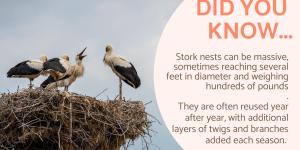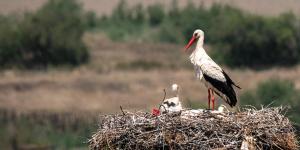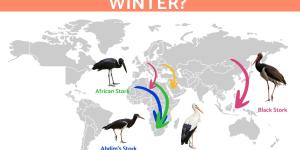What Is a Stork's Nest Called?


A stork nest is simply called a nest. Unlike eagles and other birds of prey which have a specific term for their nest (eyrie), a stork nest does not have a special name. This does not mean that stork nests are ordinary or unremarkable. Far from it, storks have one of the most fascinating nests in all of the animal kingdom. It also doesn't mean that a stork nest doesn't have other terms to describe it. These structures are able to incubate the eggs and help rear the young of these large and elegant birds.
At AnimalWised, we ask what is a stork nest called? In our answer, we look at how storks build nests and discover how much they weigh, something which makes them quite special among bird nests. We also share photos of some incredible stork nests found in nature.
What is a stork nest called?
As stated in the introduction, stork nest is simply called a nest. Some birds have specialized terms for their nests, but most do not. However, different types of birds have different types of nest. A stork has a nest called a platform nest.
All platform nests are large and bulky, the stork not being an exception. Stork nests are built mostly from branches and other materials such as leaves and grasses. Some storks have even been known to incorporate anthropogenic materials into their nest builds, although how much appears to differ according to each population[1]. This is thanks to storks building nests near human settlements and using human waste as building material.
Since they are platform nests, stork nests are built up high. Storks have a reputation for remaining at heigh. This has led to them having great cultural significance as surveyors and protectors. The nests themselves are a striking visual symbol in many rural areas, standing out on towers, electric poles and rooftops, among other high locations.
The size of individual stork nests varies, but on average they are 3.3-6.6 ft (1-2 m) in diameter and can be up to 3.3 ft (1 meter) high. The nests are sturdy and well-packed, able to withstand harsh weather conditions. These nests are used for long periods of time, with the storks adding more materials each breeding season. This causes the nests to grow even larger over time. For this reason, some of the largest stork nests in the world have reached extraordinary dimensions.
Storks are slender in frame and have noticeably long legs and beaks. Learn about other birds with long beaks in our related guide.
Where do storks nest?
Storks prefer to make their nests in elevated places in their breeding areas. This allows them to have a clear view of the surrounding area and be protected from predators. Traditionally, stork nests were built in tall trees or cliffs. Nowadays, it is more common to see them in human structures. Church towers, electricity poles, chimneys and building roofs are some of the preferred nesting sites of storks.
The use of human structures has allowed storks to expand their nesting range, especially in areas where tall trees are scarce. This adaptive behavior demonstrates the ability of these birds to thrive in changing environments, taking advantage of the benefits offered by human constructions. In some regions, artificial platforms have been installed to encourage storks to nest in safe sites, which also contributes to their conservation.
The photo below shows a stork which has built a nest on an electricity pole. Learn more about stork breeding sites and migration with our article asking where do storks go in winter?

How do storks make their nests?
The process of building a stork's nest is a cooperative task. Storks are generally considered monogamous birds and members of the pair actively participate in nest building. Storks start building their nests at the beginning of the breeding season, which usually occurs between the months of March and April. They use their large beaks to collect branches, sticks and leaves, which they then transport to the chosen site.
Storks build nests via the following process:
- They build a firm base with large, sturdy branches.
- They add layers of soft materials such as grass, straw or feathers, creating a comfortable platform for the eggs. Storks are meticulous in this process and spend several weeks perfecting their nest. This joint work not only ensures the nest is strong, but also strengthens the bond between the pair.
The process can take several weeks and the size of the nest depends on the storks' experience, as well as the materials available. If the pair already has a nest from previous seasons that has survived, they reuse it and add more materials to make it bigger and stronger. In addition, storks carefully look after the structure of the nest throughout the nesting period, making constant repairs and adding more branches if necessary.
Maintenance of the best is very important for storks. When they leave it during inactive seasons, it can become weakened. Strengthening and maintaining the nest ensures it is able to support the weight of the adults and the chicks. It also protects against inclement weather such as heavy rain or strong winds.
Storks are meticulous when it comes to building nests. wanting to best ensure protection for their young. For this reason, parental infanticide seems like a counterintuitive behavior. You can why this is not necessarily the case in our article explaining why storks kill their young.

How much does a stork's nest weigh?
The weight of a stork's nest varies considerably depending on the size and how many years it has been used. On average, a stork's nest can weigh between 220 and 550 lb (100 and 250 kg). However, there are records of the largest stork nests in the world weighing up to 1,100 lb (500 kg) due to their prolonged use and the amount of material they have accumulated.
The size and weight of the nests are a reflection of the birds' behavior of reusing and rebuilding them year after year. This allows them to create an increasingly solid structure, but it also means that some nests can become dangerously heavy if they are in unstable locations or if the weather is particularly adverse. If you look at the photo below, you can see how precarious the stork nest is due to its height.
The weight of the nest is also an indication of the longevity and reproductive success of a stork pair. The larger the nest, the more breeding seasons it has survived and the more generations of storks have been raised in it. This makes nests not only safe havens for the young, but also monuments to the reproductive success of the stork.
You can learn even more fascinating information about these birds with our article on surprising stork facts.

If you want to read similar articles to What Is a Stork's Nest Called?, we recommend you visit our Facts about the animal kingdom category.
1. Jagiello, Z., Dylewski, Ł., Aguirre, J. I., Białas, J. T., Dylik, A., López-García, A., Kaługa, I., Olszewski, A., Siekiera, J., & Tobółka, M. (2023). The prevalence of anthropogenic nest materials differs between two distinct populations of migratory birds in Europe. Environmental science and pollution research international, 30(26), 69703–69710.
https://doi.org/10.1007/s11356-023-27156-1
- Bouton, S. N., Frederick, P. C., Rocha, C. D., Dos Santos, A. T. B., & Bouton, T. C. (2005). Effects of tourist disturbance on wood stork nesting success and breeding behavior in the Brazilian Pantanal. Waterbirds, 28(4), 487-497.
https://doi.org/10.1675/1524-4695(2005)028[0487:EOTDOW]2.0.CO;2 - Cheng, L., Zhou, L., Yu, C., Wei, Z., & Li, C. (2023). Flexible nest site selection of the endangered Oriental Storks (Ciconia boyciana): Trade-off from adaptive strategies. Avian Research, 14, 100088.
https://doi.org/10.1016/j.avrs.2023.100088 - López-García, A., & Aguirre, J. I. (2023). White storks nest at high densities near landfills, changing stork nesting distributions in the last four decades in Central Spain. Ornithological Applications, 125(2), duad009.
https://doi.org/10.1093/ornithapp/duad009 - López-García, A., Martínez-Miranzo, B., & Aguirre, J. I. (2023). Influence of landfill use on nest-site selection and breeding success in white storks. Journal of Zoology, 321(3), 175-187.
https://doi.org/10.1111/jzo.13026 - Onmuş, O., Ağaoğlu, Y., & Gül, O. (2012). Environmental factors affecting nest-site selection and breeding success of the white stork (Ciconia ciconia) in western Turkey. The Wilson Journal of Ornithology, 124(2), 354-361.
https://doi.org/10.1676/11-160.1








